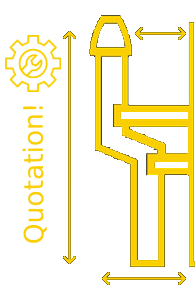Chimney Extension
CHIMNEY EXTENSION
If you have planned your chimney to be shorter than it is prescribed or if it has too little draft, you need a chimney extension. In the online shop of Eschimney.co.uk you can easily order your chimney extensions in the twin wall and single wall version. They can also be retrofitted to the chimney without much effort. However, it should be attached to the roof with a mounting plate.
More draft thanks to chimney extensions
The chimney extension is primarily used to extend the chimney. The length is decisive for the draft and thus also for the ability to completely discharge smoke gases into the outside air. The length of the chimney means that the negative pressure is created and thus the exhaust gases are practically sucked outwards. If this negative pressure is not strong enough, your chimney is too short.
Chimney too short - what could be the consequences?
When installing a chimney, you should take special care that you comply with all fire safety regulations. For example, you should make sure that all necessary minimum distances to combustible materials such as walls, doors, windows and the roof are observed. To ensure this is the case, your district chimney sweeper will need to inspect and approve the stainless steel chimney after it is installed. However, this can change again after a modification, so that the minimum clearances are no longer available. The chimney can also be shut down until all fire regulations are met again. And in the worst case, too little drag can have serious health consequences.
If there is too little draft, it can happen that the exhaust gases are not properly carried outside and get back inside. This could cause life-threatening carbon monoxide poisoning.
Reasons for extending your chimney
In addition to too little draft, there are other reasons to install a chimney extension:
• A densely built-up settlement: Especially in larger neighborhoods and residential areas, the minimum distance to neighboring windows or balconies can no longer be maintained. Chimney extensions are used for this. Chimney extensions have been used more frequently, especially since the guidelines and regulations were tightened.
• Brick chimney extension: A chimney extension that has been bricked up can also be replaced by an extension made of stainless steel. The reason for an extension made of stainless steel is usually that the brick chimneys often have a double structure of the shafts. Unfavorable wind conditions could transport the exhaust gases back into the house through the fresh air duct.
The components of a chimney extension
Despite the two different types of chimney extensions (single wall and twin wall), they consist of the same parts and have an identical structure. Except that the twin wall elements also have an insulating layer.
The inset
The insert is there to form the transition from the actual chimney to the chimney extension. This must therefore be tailored to the existing chimney. For example, in the case of brick chimneys, the inner profile of the insert must be rectangular. The insert is selected to match the inside diameter.
The anchor plate
The anchor plate on the chimney extension is there to securely attach the chimney extension. This is placed on the chimney head and fixed with screws. After the screw connection has been made, the gap is closed with sealing silicone so that noises are also insulated.
The extension tube
The extension pipe is actually the most important part for the smoke outlet. It is available in different sizes and can extend your chimney by up to 3 m. You should choose the inside diameter of the extension pipe so that it at least corresponds to the surface of the chimney to be extended or is larger.
The following formula can be used to calculate the inside diameter:

Accessories
In addition to the essential components of a chimney extension, there is also the option of installing an additional cleaning opening. This could make sense from an extension of 1.5 m. In addition to the cleaning opening, a rain cap would also be recommended to protect the extension from rain and moisture. A rain cap is particularly recommended if the previously existing chimney is bricked, as this can protect the brickwork from sooting.
Your advantages with a chimney extension
✓ Easy
✓ Fast
✓ Inexpensive
✓ Robust
✓ Isolated
✓ Individually









